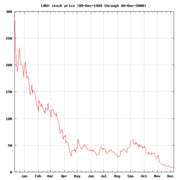Stock Ticker tape

Ticker tape was used by ticker tape machines, stock ticker machines, or just stock tickers. Invented in the 1870s, early versions of stock tickers provided the first mechanical means of conveying stock prices ("quotes"), over a long distance over telegraph wiring. Previously, they were hand-delivered via written or verbal messages. Since the useful time-span of individual quotes is very brief, they generally had not been sent long distances; aggregated summaries, typically for one day, were sent instead.
Stock tickers in various buildings were connected using technology based on the then-recently invented telegraph machines, with the advantage that the output was readable text, instead of the dots and dashes of Morse code. The machines printed a series of ticker symbols (usually shortened forms of a company's name), followed by brief information about the price of that company's stock; the thin strip of paper they were printed on was called ticker tape. As with all these terms, the word ticker comes from the distinct tapping (or ticking) noise the machines made while printing.
Stock ticker machines are an ancestor of the modern computer printer, being one of the first applications of transmitting text over a wire to a printing device. One of the earliest practical stock ticker machines, Universal Stock Ticker developed by Thomas Edison in 1870, had an alphanumeric printing speed of approximately 1 character per second. A special typewriter designed for operation over telegraph wires was used at the opposite end of the telegraph wire connection to the ticker machine. Text typed on the typewriter got displayed on the ticker machine at the opposite end of the connection. An early analog signalling method was used for text transmission between the typewriter and the stock ticker machine.
Used ticker tape was cut into a form of confetti, to be thrown from the windows above parades, primarily in lower Manhattan; this became known as a ticker-tape parade. Ticker tape parades generally celebrated some significant event, such as the end of a World War, or the safe return of one of the early astronauts.
Stock ticker machines became obsolete in the 1960s, replaced by computer networks; none have been manufactured for use for decades. However, working reproductions of at least one model are now being manufactured for museums and collectors.
Simulated ticker displays, named after the original machines, still exist as part of the display of television news channels and on some World Wide Web pages—see news ticker.
